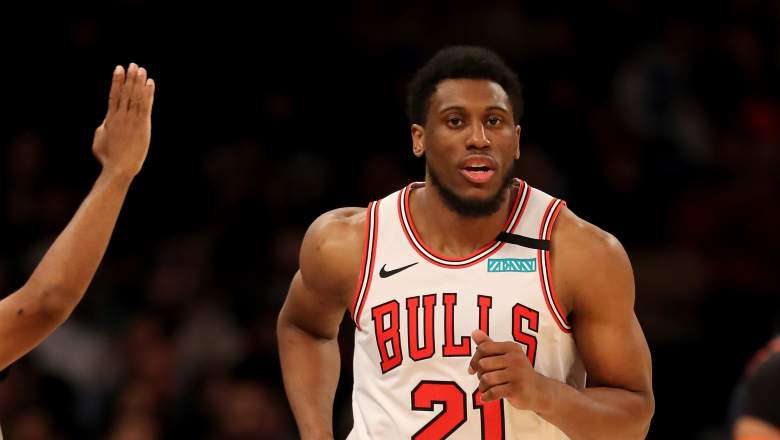
Getty Thaddeus Young #21 of the Chicago Bulls celebrates his shot in the second half against the New York Knicks at Madison Square Garden on February 29, 2020 in New York City.
The Chicago Bulls, obviously, have no regrets about their offseason move for DeMar DeRozan. Despite his relatively advanced age of 32, DeRozan is currently fifth in the NBA in scoring at 26.0 points per game, ahead of modern day legends such as Luka Doncic, Damian Lillard, Bradley Beal, Devin Booker and James Harden. He is even head of his teammate, Zach LaVine.
DeRozan has been a phenomenal return on investment for the Bulls thus far, and although his production should dwindle somewhat over the life of his contract as he enters the back nine of his career, his game should also age well. For all his still-extant athleticism, it is DeRozan’s footwork and skill set that makes him so effective from the under-represented areas of the court, and that will not leave him.
In order to get DeRozan, the Bulls gave him a three-year, $81.9 million contract, but in order to give him that, they had to acquire him via a sign-and-trade, rather than an outright signing. This meant sending a trade package of Thaddeus Young, Al-Farouq Aminu, a first-round pick and two second-round picks to the San Antonio Spurs, with whom DeRozan had spent the previous three seasons. And while the Bulls would surely do the overall trade again tomorrow, they surely wish they could do it without having to include Young.
Young Never Wanted to Leave
Having signed with the Bulls back in the summer of 2019, Young did not want to leave them, and has expressed surprise that it happened. Young’s expiring $14.19 million contract was instrumental for salary-matching purposes in constructing the deal; once it became apparent that there was no longer a pathway to trading Lauri Markkanen in a once-fancied double sign-and-trade the other way, Young had to go.
The Bulls did not want Young to go, either. In his age-33 season in 2020/21, Young had had arguably the best campaign of his career – basic averages of 12.1 points, 6.2 rebounds, 4.3 assists and 1.1 steals per game were nice, but belied a wider two-way impact that a +2.2 VORP and +8 net rating better attested to. This came on a Bulls team that, otherwise, was not very good.
In an era that has seen the power forward position revolutionised, Young has made the adjustments in subtle yet effective ways. His hybrid game that once made him a tough positional fit now makes him a nice modern-day four, and while he does not have the explosion or inordinately high skill level to level up beyond what he currently is, what he currently is more than suffices on both ends of the court.
Moreover, he is that same type of player that the Bulls now need. While it was reported recently that they are looking to acquire a wing defender, it instead seems more sensible given their depth chart at the power forward position that they find a bigger defender of opposing fours instead.
With Patrick Williams out, the Bulls have been papering over the power forward spot, often with 6’4 guard Javonte Green (whose rebounding tenacity and athleticism help overcome the deficit, but do not mask it). They need someone from that position who can guard stretch fours, play defense with length in the lane, potentially spot up from outside, take some elbow and post touches offensively, and keep the ball moving crisply for the DeRozan/LaVine duo.
That position has a giant Thad Young-shaped hole in it. He was until recently that player. Can he be it again?
Is There Any Way Young Can Return?
Time to ruin the mood. This season? Almost certainly not.
What can be said with certainty is that the Bulls cannot trade for Young. All the will in the world will not allow for that.
This is not just an issue logistically, in terms of their own salary cap situation, but also in terms of the rules of the NBA’s governing Collective Bargaining Agreement. Teams are not allowed to receive in a midseason trade a player who they traded away in the previous offseason, whereby offseasons are considered to start on the first day of the moratorium.
The moratorium began on August 3rd, the Bulls traded Young on August 11th, and thus they will not be allowed to trade for him until the start of the next offseason, which will be July 1st 2022. Considering that his contract expires at the end of the season (i.e. June 30th), there is therefore no way that the Bulls can trade back for Young.
Of course, the fact that he will be entering free agency next summer means the Bulls can sign him again then, assuming Young comes to peace with the unease with which he learned of his departure. However, even if the Spurs were to buy him out prior to his contract expiring, they still could not sign him this season.
A further rule forbids teams from re-signing waived players whom they initially traded away for one year after the date of the trade, or until the following July 1st, whichever comes first. As above, Young’s contract expires before both of these dates.
The only possible workaround would be for the Spurs to trade Young to another team, and for that team to then waive him – after that, the Bulls would be free to sign Young again this season. But for that to happen, a team would need to trade for Young and immediately not want him. This seems overwhelmingly unlikely to happen, and therefore, so does Young’s return to Chicago.
The Bulls could use Thaddeus Young, he never wanted to leave, and he is unhappy at his limited playing time with the Spurs, yet such a deal is almost entirely prohibited. Blame Gary Payton.